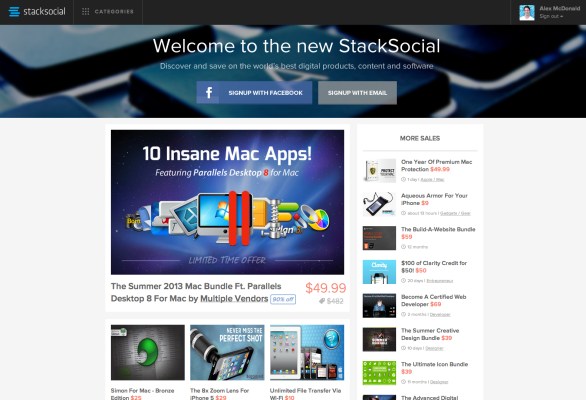StackSocial, an e-commerce platform that provides its users with discounts and special offers on software and hardware, has launched its redesigned site to display increased inventory and help users discover products more easily. CEO Josh Payne tells me in the coming weeks the company will implement more community features, such as the ability to “want” or “heart” a product, as well as add gaming and design products to its catalogue.
The company has also announced a partnership to sell products through Apple-centric blog TUAW, which is owned by AOL. While Payne says it wasn’t a part of the original plan, the startup sells merchandise through 24 publishing partners, which accounts for about 50 percent of sales. Each publishing partner uses a StackSocial-powered platform to sell related tech gadgets at a discounted price. Readers get direct access to relevant products, and publications receive 30 to 50 percent of product sales. Partners include Cult of Mac, Digital Trends, 9to5Mac, VentureBeat and more.
“If we don’t have any differentiator between ourselves and say, Amazon for instance, there’s not much of incentives for a user to purchase from us. So we’re really looking to [provide] those unique, trending, maybe independently developed products that not everyone has heard of yet,” Payne tells me.
While there are several other services that offer deals through bundling, such as NimbleCommerce and AppSumo, StackSocial is focused specifically on technology. This specific niche is especially handy for reaching a larger consumer base through related publisher partners. Payne says he expects to see sales from partners reach 80 percent in the near future. Several publisher partners are also focused on gaming and design, which explains the expansion into selling those products.
A large challenge facing StackSocial is maintaining consistency in users. The startup has over 425,000 registered users across all its sales platforms, which isn’t a huge amount considering its potential customer base, and the fact that customers are coming in from more than 20 sources.
“One of the ways we are going to look to scale is by having inventory that persists, as well as having inventory that’s more self-serve from vendors,” Payne says. “Just as companies like Gilt and Fab are beginning to evolve into more of a marketplace as opposed to a flash sale type of model, I think we are beginning to do something very similar.”
Founded in 2011, StackSocial has over 400 affiliate partners and 330 vendor partners, and raised a seed round of $800,000 in 2012.
